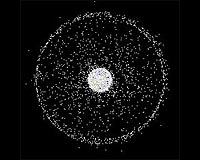 |
66th Air Base Group Public Affairs Hanscom AFB (AFNS) Oct 29, 2010 Electronic Systems Center officials released a request for proposal announcement Oct. 20, 2010, for the next phase of a program that will revamp the way space objects and debris are identified and tracked. The Space Fence program, with a total anticipated value of more than $3.5 billion, will deliver a system of geographically dispersed ground-based sensors to provide timely assessment of space events, said program manager Linda Haines. "That will allow us to reduce susceptibility to collision or attack, improve the space catalog accuracy and provide safety of flight," she said. In this upcoming phase, ESC officials will award up to two preliminary design review contracts worth up to a total of $214 million. During the 18-month period of performance, the contractor or contractors will be expected to develop preliminary system designs, radar performance analyses, evaluations and prototypes, and conduct other technical activities. This work will address critical technology elements and critical manufacturing processes, key technical risks, and production and life cycle costs to reduce total program technical, cost, schedule and performance risk, Ms. Haines said. These activities are critical to ensure "a time-certain delivery schedule" to meet Air Force Space Command's 2015 initial operational capability need date. Space situational awareness is now a national security priority, Ms. Haines said, with findings provided to Congress highlighting just how complex, congested and contested space is becoming. The Space Fence will form the foundation for full SSA by providing U.S. Strategic Command joint space control capabilities. Those capabilities will offer better uncued surveillance, providing improved timeliness, higher cataloguing accuracy and completeness, launch coverage and object characterization. "All of these contribute to space flight safety in the increasingly congested space environment," Ms. Haines said. The Space Fence will use multiple S-band ground-based radars - the exact number will depend on operational performance and design considerations - that will permit uncued detection, tracking and accurate measurement of orbiting space objects. It will replace the Air Force Space Surveillance System, or VHF Fence, that's been in service since 1961. The program transferred from the Navy to the Air Force in 2004. The higher wave frequency of the new Space Fence will allow detection of much smaller microsatellites and debris in low Earth orbit, Ms. Haines said. The "fence" is created by the strategic placement of multiple radars that cover enough continuous area to track space objects when they enter the Earth's orbit at certain angles. The land-based, geographically dispersed sites will significantly improve the timeliness with which operators can detect "space events." Several incidents, including the February 2009 collision of a U.S. Iridium communications satellite and a Russian Cosmos 2251 communications satellite, demonstrate the need for this more capable and precise tracking capability, Ms. Haines said. That collision alone added hundreds of pieces of debris to the atmosphere, she said. "The Space Fence is going to be the most precise radar in the space situational surveillance network," Ms. Haines said. "The S-band capability will provide the highest accuracy in detecting even the smallest space objects." That, in turn, will help avoid additional space collisions, which would otherwise add to the thousands of existing objects and debris already in space. All these objects present potential threats for communication or GPS satellites or even NASA's International Space Station and the shuttle. After completion of this phase in 2012, ESC officials expect to award a production contract that will lead to final system development, fielding and full operational capability. In June 2009, ESC officials awarded three $30-million competitive, multi-contractor concept development contracts. That work provided system design and architecture trades and analyses. It also supplied modeling and simulation and prototyping. All of this helps reduce risks and informs government capability requirements, radar performance and cost estimates. Those efforts, only two of which continued after February 2010 due to budget restrictions, will complete in December. They include detailed analyses of key performance parameters - number, size, and range of objects and the number and location of ground sensors - measured against cost and current and evolving space environments. The center, via what was then the 850th Electronic Systems Group, awarded the three contracts to Lockheed Martin, Northrop Grumman and Raytheon. "The key result of the SDR Phase was the optimization of operational and system requirements through more than 80 government-contractor architecture trades and analyses, modeling and simulation and prototyping activities, to ensure affordable, achievable approaches to an on-time delivery," Ms. Haines said. "We were able to reduce projected lifecycle costs by $3 to $4 billion and still meet required mission performance, through these cost-reduction-focused activities."
Share This Article With Planet Earth
Related Links - Space Technology News - Applications and Research
 Secure World Foundation Holds Space Debris Workshop
Secure World Foundation Holds Space Debris WorkshopBeijing, China (SPX) Oct 26, 2010 International participants from a dozen universities around the world, including the United States, United Kingdom, Spain, Russia, and Japan, along with faculty and graduate students from across China, participated in the 2010 Beijing Space Debris Mitigation Workshop, held on October 18-19 in Beijing, China. Secure World Foundation, along with its partners at Beihang University in Beijing ... read more |
|
| The content herein, unless otherwise known to be public domain, are Copyright 1995-2010 - SpaceDaily. AFP and UPI Wire Stories are copyright Agence France-Presse and United Press International. ESA Portal Reports are copyright European Space Agency. All NASA sourced material is public domain. Additional copyrights may apply in whole or part to other bona fide parties. Advertising does not imply endorsement,agreement or approval of any opinions, statements or information provided by SpaceDaily on any Web page published or hosted by SpaceDaily. Privacy Statement |